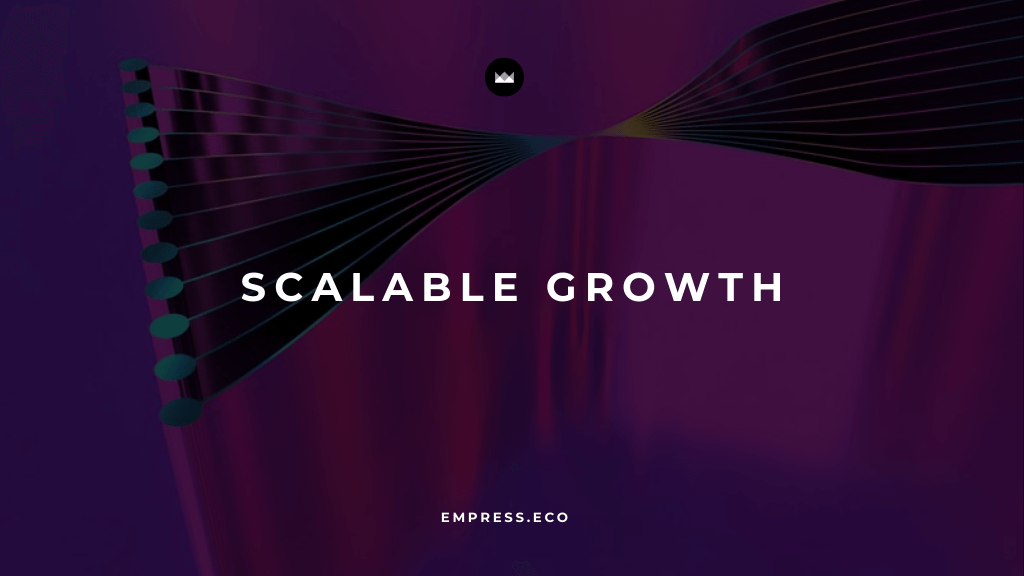
Mastering Scalable Growth Systems
Building a Foundation for Sustainable Business Expansion
Table of Contents
When we talk about business expansion, it's easy to get caught up in the excitement of growth—more customers, more revenue, and a larger market presence. However, growth that isn’t carefully managed can quickly spiral out of control, leading to inefficiencies, strained resources, and missed opportunities. The key to sustainable expansion is scalability, and that’s where scalable growth systems come into play.
Understanding Scalable Growth Systems
Let’s start by breaking down what we mean by scalable growth systems. At its core, a scalable system is one that can handle increased demand without a corresponding increase in costs. Think of it as a foundation that’s built to grow with your business, allowing you to expand your operations without the growing pains that often come with rapid scaling.
In practical terms, this means creating systems—whether they be in marketing, sales, operations, or technology—that can accommodate more volume, more customers, and more data without breaking down or requiring significant additional resources. The goal is to create efficiencies that enable your business to grow smoothly and sustainably.
Why Scalable Growth Systems Matter
Imagine you’re running a small business that’s starting to gain traction. Your marketing efforts are paying off, and suddenly, you’re seeing a surge in customer inquiries and orders. This is fantastic, right? But what happens if your current systems aren’t equipped to handle this influx? Orders start getting delayed, customer service slips, and soon, what was once a positive growth trajectory starts to cause frustration—both for you and your customers.
This scenario highlights why scalable growth systems are so critical. They ensure that as your business grows, you can continue to deliver the same level of service and quality that your customers expect. Scalable systems allow you to manage increased workloads efficiently, optimize resource use, and maintain consistent performance, even as demand grows.
The Benefits of Scalable Growth Systems
To really grasp the importance of scalability, let’s explore some of the key benefits that come with building scalable growth systems.
1. Efficient Resource Utilization
One of the biggest advantages of scalable systems is that they allow you to do more with less. Instead of needing to continually add resources—like staff, equipment, or software licenses—as your business grows, scalable systems enable you to handle increased workloads without a proportional increase in costs.
For example, consider your lead generation efforts. In a non-scalable system, you might need to hire additional staff to manage an influx of leads. However, with a scalable lead generation system, you could automate many of these processes, allowing your existing team to handle a higher volume of leads without becoming overwhelmed. This efficiency not only reduces costs but also allows you to grow more quickly and with fewer constraints.
2. Consistent Lead Flow
Consistency is key in business, especially when it comes to lead generation. Traditional lead generation methods can often be unpredictable, with ebbs and flows that make it difficult to maintain a steady sales pipeline. Scalable systems, however, are designed to provide a consistent flow of high-quality leads.
This consistency comes from automation and strategic planning. For instance, by automating your email marketing campaigns, you can ensure that your messages are reaching potential leads at the right time, regardless of your team’s workload. Similarly, by using SEO strategies that scale with your content efforts, you can continue to attract organic traffic and generate leads consistently over time.
3. Adaptability to Market Changes
Markets are dynamic, and the ability to adapt quickly to changes is a major competitive advantage. Scalable systems are inherently adaptable, designed to adjust to shifts in market conditions, customer behavior, or even internal business needs.
Let’s say there’s a sudden change in your industry—maybe a new competitor enters the market, or there’s a shift in consumer preferences. A scalable system allows you to pivot your strategy without disrupting your operations. Whether it’s updating your marketing tactics, adjusting your product offerings, or scaling up your customer service, scalable systems give you the flexibility to respond to change without missing a beat.
4. Enhanced Competitive Advantage
In business, the ability to grow quickly and efficiently can set you apart from the competition. Scalable growth systems enable you to capture market share more effectively by allowing you to scale your operations in response to increased demand or new opportunities.
For example, if you’re in an industry where rapid growth is essential—like technology or e-commerce—scalable systems allow you to expand your reach, increase your customer base, and enhance your market presence without the growing pains that might slow down a less prepared competitor. This advantage can be crucial in markets where speed and efficiency are key to staying ahead.
Building Scalable Growth Systems: A Step-by-Step Approach
Now that we’ve covered why scalable systems are important, let’s dive into how you can build these systems for your own business. The process involves a combination of strategic planning, investment in the right tools, and continuous optimization.
Step 1: Assess Your Current Systems
The first step in building scalable growth systems is to take a close look at your current operations. This means assessing your existing processes, tools, and resources to identify areas where scalability might be an issue.
Ask yourself:
- Which processes are most time-consuming or resource-intensive?
- Where are the bottlenecks in your current operations?
- Are there areas where demand is already outpacing your capacity?
By identifying these pain points, you can begin to prioritize the areas that need the most attention. For example, if your customer service team is struggling to keep up with inquiries, that might be a sign that you need to invest in scalable solutions like AI-powered chatbots or more robust CRM software.
Step 2: Invest in Automation Tools
Automation is one of the most powerful tools for building scalable systems. By automating repetitive tasks, you free up your team to focus on more strategic work, and you create processes that can easily handle increased demand without additional human intervention.
Consider the various areas of your business that could benefit from automation:
- Marketing Automation: Tools like HubSpot or Marketo can automate email campaigns, social media posts, and lead nurturing activities, ensuring that your marketing efforts are consistent and scalable.
- Sales Automation: CRM systems like Salesforce can automate lead tracking, sales forecasting, and customer follow-ups, helping your sales team manage more leads with less manual effort.
- Customer Service Automation: AI-powered chatbots can handle common customer inquiries, provide 24/7 support, and escalate more complex issues to human agents when necessary.
By investing in these tools, you’re not only increasing your efficiency but also building systems that can grow with your business.
Step 3: Optimize for SEO and Content Marketing
Search engine optimization (SEO) is another crucial component of scalable growth. By optimizing your website and content for search engines, you can increase your online visibility and drive a steady stream of organic traffic to your site—traffic that can be converted into leads and customers.
Here’s how to get started:
- Keyword Research: Identify the keywords and phrases that your target audience is searching for. Tools like Google Keyword Planner or Ahrefs can help you discover high-value keywords that are relevant to your business.
- Content Creation: Create high-quality, informative content that addresses the needs and interests of your target audience. This could include blog posts, whitepapers, case studies, or videos. Make sure your content is optimized with the keywords you’ve identified.
- On-Page Optimization: Ensure that your website is optimized for search engines. This includes optimizing title tags, meta descriptions, headers, and images with relevant keywords, as well as ensuring that your site is mobile-friendly and has fast loading times.
- Link Building: Build backlinks to your site from reputable sources. This not only drives referral traffic but also boosts your site’s authority in the eyes of search engines, helping you rank higher in search results.
By focusing on SEO and content marketing, you’re creating a scalable system for lead generation that can continue to drive traffic and generate leads as your business grows.
Step 4: Leverage Social Media for Scalable Outreach
Social media is another powerful tool for scalable lead generation. Platforms like Facebook, LinkedIn, Twitter, and Instagram offer opportunities to reach a wide audience with relatively little manual effort.
Here’s how you can leverage social media effectively:
- Automate Posting: Use tools like Buffer or Hootsuite to schedule and automate your social media posts. This ensures that your content is consistently reaching your audience, even when your team is focused on other tasks.
- Targeted Advertising: Social media platforms offer advanced targeting options that allow you to reach specific audiences based on demographics, interests, and behavior. By running targeted ads, you can generate leads at scale without significantly increasing your workload.
- Engage with Your Audience: While automation is important, don’t forget the value of authentic engagement. Responding to comments, messages, and mentions in real-time helps build relationships and trust with your audience, leading to higher conversion rates.
By integrating social media into your scalable growth systems, you can expand your reach and generate more leads without a proportional increase in effort.
Step 5: Repurpose High-Performing Content
Creating content is time-consuming, but the good news is that you don’t always have to start from scratch. Repurposing high-performing content allows you to extend its reach and generate additional leads with minimal extra effort.
Here’s how to repurpose content effectively:
- Transform Blog Posts into Videos: If you have a blog post that’s performed particularly well, consider turning it into a video. Video content is highly engaging and can be shared across multiple platforms, reaching a broader audience.
- Create Infographics: Take data or key points from a successful piece of content and turn them into an infographic. Infographics are visually appealing and can be shared easily on social media or included in presentations.
- Compile eBooks or Guides: If you’ve written a series of related blog posts, compile them into an eBook or comprehensive guide. This not only provides value to your audience but also gives you a lead magnet that can be used to capture email addresses and build your list.
Repurposing content is an efficient way to scale your content marketing efforts, allowing you to get more mileage out of the content you’ve already created.
Step 6: Outsource Key Functions
As your business scales, you’ll likely find that you can’t do everything in-house. Outsourcing certain functions can help you scale your lead generation efforts without overburdening your internal teams.
Consider outsourcing the following:
- Content Creation: Partner with a content marketing agency or freelance writers to produce high-quality content at scale. This frees up your internal team to focus on strategy and execution.
- Lead Generation: Use a specialized lead generation firm to manage your outbound marketing efforts. These firms often have expertise and tools that can help you generate leads more efficiently than if you were handling everything internally.
- Customer Service: Consider outsourcing customer service functions to a third-party provider. This allows you to scale your customer support operations without needing to hire and train additional staff.
Outsourcing allows you to access specialized expertise and maintain efficiency as your business grows, ensuring that you can continue to deliver high-quality service and generate leads at scale.
Challenges and Considerations in Building Scalable Systems
While scalable growth systems offer numerous benefits, they also come with their own set of challenges. It’s important to be aware of these challenges so you can address them proactively.
1. Initial Investment
Building scalable systems often requires a significant upfront investment in technology, tools, and process development. This can be a barrier for some businesses, especially smaller ones with limited budgets.
However, it’s important to view these investments as foundational. The efficiencies and capabilities that scalable systems provide can lead to significant long-term savings and revenue growth. When evaluating potential investments, consider the return on investment (ROI) over the long term, rather than just the initial cost.
2. Maintaining Lead Quality
As you scale your lead generation efforts, maintaining lead quality can become a challenge. It’s easy to get caught up in generating large volumes of leads, but if those leads aren’t well-qualified, they won’t convert into customers.
To maintain lead quality:
- Implement rigorous lead qualification processes to ensure that only the most promising leads are passed to your sales team.
- Use AI-driven lead scoring to prioritize leads based on their likelihood to convert, ensuring that your team is focusing on high-quality opportunities.
- Regularly review and refine your lead generation strategies to ensure they’re targeting the right audience and generating leads that meet your criteria.
By focusing on lead quality as well as quantity, you can ensure that your scalable systems deliver the best possible results.
3. Data Integration
Effective scalability requires seamless integration of data across various systems and platforms. Without proper integration, you risk creating data silos that hinder your ability to make informed decisions and optimize your lead generation strategies.
To ensure smooth data integration:
- Invest in integrated software solutions that work together seamlessly, such as CRM systems that integrate with marketing automation platforms.
- Use middleware or APIs to connect disparate systems, ensuring that data flows smoothly across your organization.
- Regularly audit your data to ensure accuracy and consistency across all platforms.
By prioritizing data integration, you can create a more cohesive and effective scalable growth system.
Conclusion: Building a Foundation for Sustainable Expansion
Scalable growth systems are essential for businesses seeking to expand their operations and increase their market presence. By implementing scalable lead generation strategies, companies can efficiently manage increased demand, optimize resources, and achieve sustainable growth.
As we’ve explored, scalable systems offer a range of benefits, from efficient resource utilization and consistent lead flow to adaptability and enhanced competitive advantage. However, building these systems requires careful planning, investment in the right tools, and a focus on maintaining lead quality and data integration.
By taking a strategic approach to scalability, your business can lay the foundation for sustainable expansion and long-term success. As markets continue to evolve and demands increase, those with scalable growth systems in place will be best positioned to thrive.
In summary:
- Scalable systems ensure efficient resource utilization and provide consistent lead flow.
- Adaptable strategies allow businesses to respond quickly to market changes.
- Investments in automation, SEO, and content repurposing are key to building scalable growth systems.
- Outsourcing and data integration are critical for maintaining efficiency and effectiveness as you scale.
By embracing these strategies, you can build a scalable growth system that supports your business’s expansion goals, ensuring that your growth is both sustainable and successful.
Empress Newsletter
Join the newsletter to receive the latest updates in your inbox.



